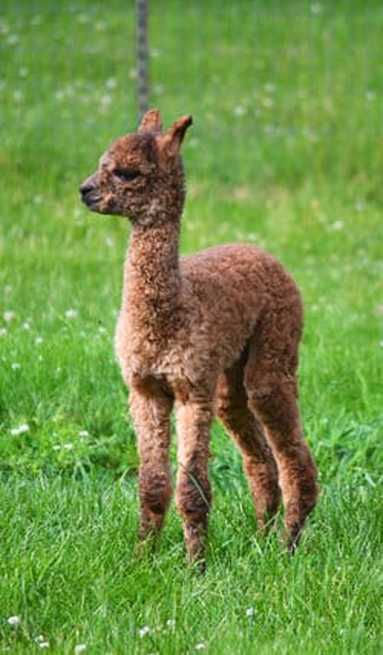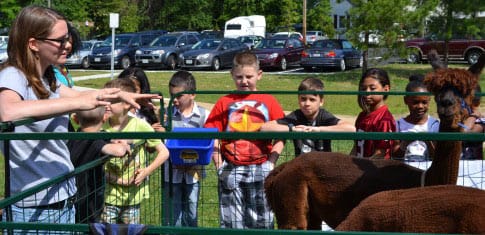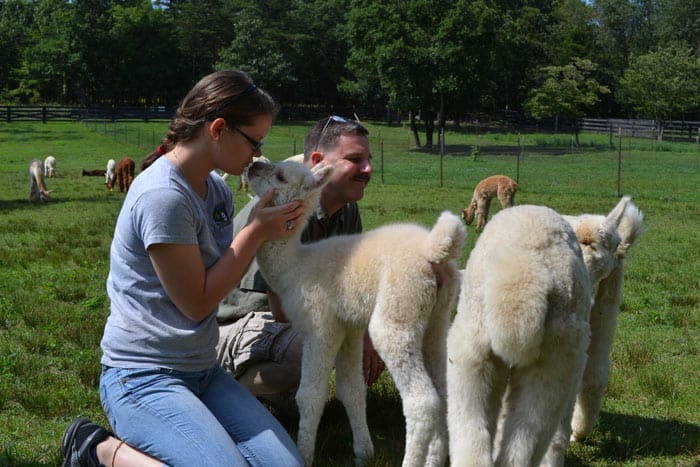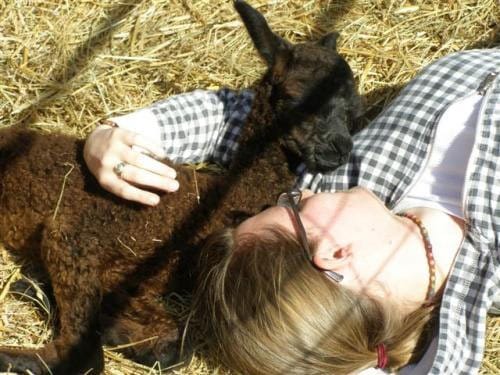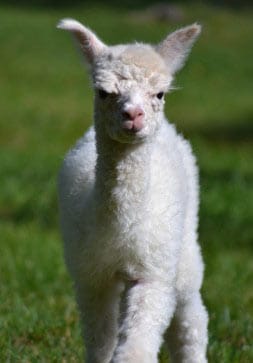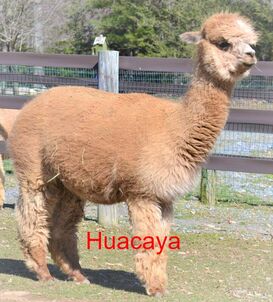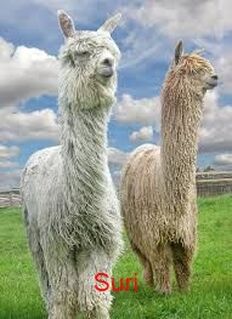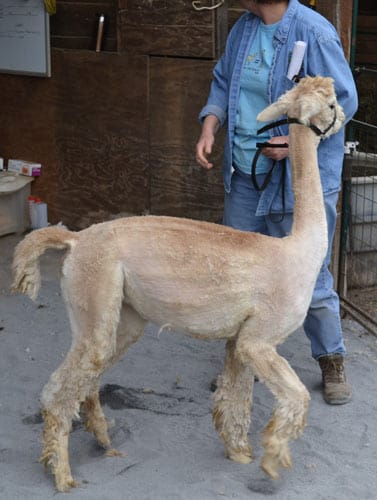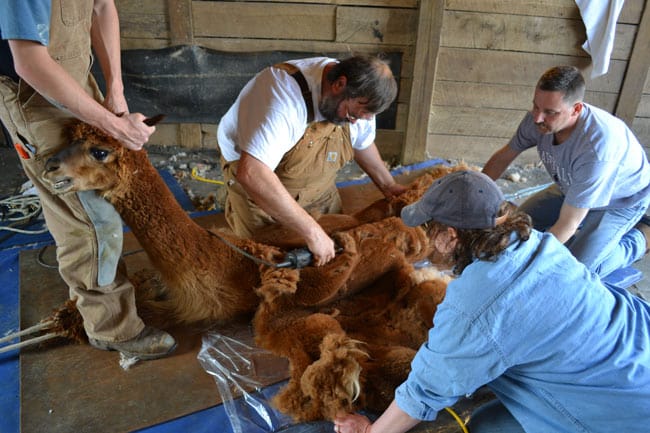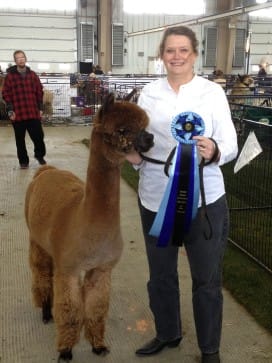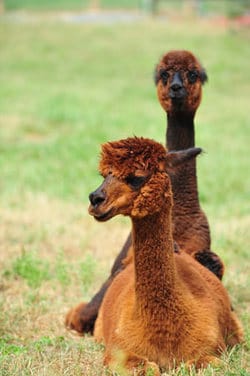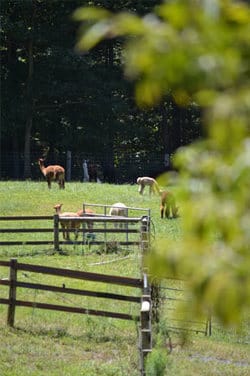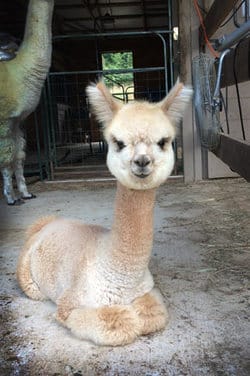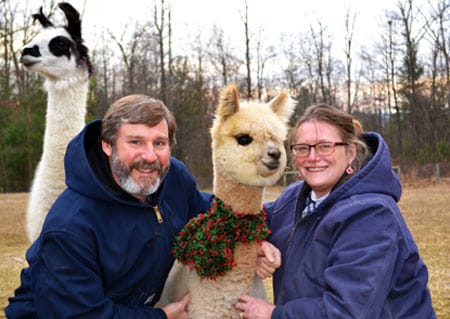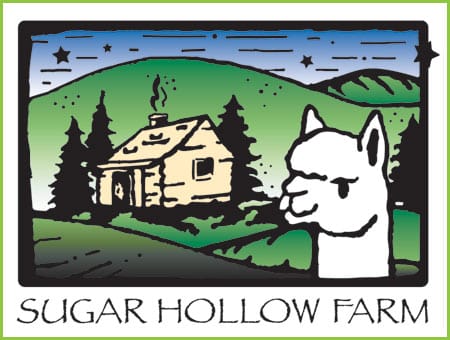FAQ - Frequently Asked Questions
Here are answers to a few frequently asked questions about alpacas:
|
Are alpacas really easy to take care of?
Yes, they really are. Many people that have never lived on a farm, or had livestock are finding that alpacas are the perfect animal to have. They are small and non-aggressive. Alpacas are very smart, and once they know the routine, and what you want, they are very cooperative. They are gentle and easy to handle. Clean-up is easy since alpacas deposit droppings in only a few places in the paddock. Their waste, called beans, is virtually odorless and about the size of navy beans. A small rake and shovel are all that are required along with a bin or wheelbarrow in which to deposit the droppings. Regular care includes: trimming their toenails every couple of months, shearing them once a year, and giving a monthly injection to protect them from parasites. |
Do alpacas like people?
Alpacas are very gentle and inquisitive but may be a bit anxious around strange people or unfamiliar surroundings. The more you work with them, the more comfortable they will be. Most recognize their feed buckets, and will come eagerly when they see them. This is also a great way to introduce new people to your herd. Give them a feed bucket, and the alpacas will quickly make friends. Children particularly love feeding alpacas from their hands.
Alpacas are very gentle and inquisitive but may be a bit anxious around strange people or unfamiliar surroundings. The more you work with them, the more comfortable they will be. Most recognize their feed buckets, and will come eagerly when they see them. This is also a great way to introduce new people to your herd. Give them a feed bucket, and the alpacas will quickly make friends. Children particularly love feeding alpacas from their hands.
Why is there so much interest in alpacas?
Alpacas are raised mainly for their fiber. Soft as cashmere and warmer, lighter and stronger than wool, it comes in more colors than any other animal fiber (16 official colors). Spinners and weavers around the world now enjoy this cashmere-like fleece, once reserved for Incan royalty.
The alpaca textile industry is new and growing rapidly. Alpaca fiber is sold several ways. Hand-spinners and fiber artists buy raw fleece. Knitters often purchase alpaca yarn. Fiber cooperatives collect alpaca fiber and process it on behalf of the producer.
Along with providing an excellent investment opportunity, alpacas have given countless people the opportunity to enjoy a more relaxed lifestyle.
Alpacas are raised mainly for their fiber. Soft as cashmere and warmer, lighter and stronger than wool, it comes in more colors than any other animal fiber (16 official colors). Spinners and weavers around the world now enjoy this cashmere-like fleece, once reserved for Incan royalty.
The alpaca textile industry is new and growing rapidly. Alpaca fiber is sold several ways. Hand-spinners and fiber artists buy raw fleece. Knitters often purchase alpaca yarn. Fiber cooperatives collect alpaca fiber and process it on behalf of the producer.
Along with providing an excellent investment opportunity, alpacas have given countless people the opportunity to enjoy a more relaxed lifestyle.
Are alpacas dangerous?
No. Alpacas do not bite or butt. I never recommend approaching any animal from behind, as it may kick if startled. One of the nicest things about alpacas is that even young children can enjoy and participate in caring for them without fear. If alpacas don’t want to be handled they will simply move away as they are approached.
No. Alpacas do not bite or butt. I never recommend approaching any animal from behind, as it may kick if startled. One of the nicest things about alpacas is that even young children can enjoy and participate in caring for them without fear. If alpacas don’t want to be handled they will simply move away as they are approached.
How big does an alpaca get?
An adult alpaca averages between 32″ to 39″ tall at the withers (shoulder) and weighs between 100 – 200 pounds.
An adult alpaca averages between 32″ to 39″ tall at the withers (shoulder) and weighs between 100 – 200 pounds.
How long do alpacas live?
The average life span of an alpaca is around 20 years.
The average life span of an alpaca is around 20 years.
Are there different kinds of alpacas?
There are two types of alpacas – Huacaya (wah-ki-ah) and Suri (sir-e). The suri’s fiber grows quite long and forms silky, pencil-like locks. The huacaya has a shorter, dense, crimpy fleece, giving it a very woolly appearance.
There are two types of alpacas – Huacaya (wah-ki-ah) and Suri (sir-e). The suri’s fiber grows quite long and forms silky, pencil-like locks. The huacaya has a shorter, dense, crimpy fleece, giving it a very woolly appearance.
How much acreage does it take to raise alpacas?
Depending on the quality of the pasture between five and ten alpacas per acre. Alpacas are gentle on the land and environmentally friendly. Alpacas have soft padded feet that do not damage pastures.
Can I start out with one alpaca?
No. Alpacas need to have a herd to thrive. A herd of two might work, but three is better. Alternatively, you can purchase one alpaca and board it on an established alpaca farm. That way you can slowly grow your herd while learning about the care and maintenance of these wonderful animals.
No. Alpacas need to have a herd to thrive. A herd of two might work, but three is better. Alternatively, you can purchase one alpaca and board it on an established alpaca farm. That way you can slowly grow your herd while learning about the care and maintenance of these wonderful animals.
What do alpacas eat?
Alpacas are modified ruminants with a three-compartment stomach that converts grass and hay to energy very efficiently. Alpacas do best on pasture grass which is supplemented with quality hay from late fall to spring. On average 15 alpacas will consume one 45-pound bale of hay each day. Additionally, our alpacas receive about a 1/2 cup of pelleted grain each day to provide needed vitamins and minerals.
Alpacas are modified ruminants with a three-compartment stomach that converts grass and hay to energy very efficiently. Alpacas do best on pasture grass which is supplemented with quality hay from late fall to spring. On average 15 alpacas will consume one 45-pound bale of hay each day. Additionally, our alpacas receive about a 1/2 cup of pelleted grain each day to provide needed vitamins and minerals.
Do I need a barn to have alpacas?
Alpacas are a very hardy animal from the Andes Mountains in South America. During the winter they have a good heavy fleece to keep them warm and dry. Many alpaca breeders in this area use open three-sided shelters. This allows the alpacas to come and go as they please while providing shelter from the wind, rain and snow if they desire it. A good layer of gravel allows liquids to drain away, and is a good option for the floor.
Alpacas are a very hardy animal from the Andes Mountains in South America. During the winter they have a good heavy fleece to keep them warm and dry. Many alpaca breeders in this area use open three-sided shelters. This allows the alpacas to come and go as they please while providing shelter from the wind, rain and snow if they desire it. A good layer of gravel allows liquids to drain away, and is a good option for the floor.
What type of fence do I need?
Alpacas are not known for challenging fences, and they usually do not wander far if they get out. However, a good fence is vitally important to keep alpacas safe from predators. Even a neighborhood dog can be dangerous to alpacas.
Four foot tall woven wire fencing with 2″ x 4″ openings work well. Field fencing is also a good option, and can often be purchased more economically. The openings at the top are larger and become smaller as you get closer to the ground.
Many people use a combination of fencing for the best protection of their alpacas. For example a strand of barbed wire run along the outside of the fence will help keep dogs, coyotes and other predators from digging under the fence.
Alpacas are not known for challenging fences, and they usually do not wander far if they get out. However, a good fence is vitally important to keep alpacas safe from predators. Even a neighborhood dog can be dangerous to alpacas.
Four foot tall woven wire fencing with 2″ x 4″ openings work well. Field fencing is also a good option, and can often be purchased more economically. The openings at the top are larger and become smaller as you get closer to the ground.
Many people use a combination of fencing for the best protection of their alpacas. For example a strand of barbed wire run along the outside of the fence will help keep dogs, coyotes and other predators from digging under the fence.
|
How do I get their fleece off them?
Alpacas produce one of the world’s finest and most luxurious natural fibers. It is clipped from the animal without causing it injury once a year in a process called shearing. When you purchase your alpacas, ask the breeder for the name of a good shearer. The cost is around $30.00 per animal, and does not take long. The amount of fleece you get from each animal varies from 3 to 10 pounds. |
How do I transport an alpaca?
For traveling short distances many people use vans, mini vans, and even station wagons. We actually managed to get one in the back of our Prius once! An old piece of carpet or heavy canvas will help protect the vehicle from damage. Once moving, the majority of alpacas will quietly cush (lay down). A livestock trailer is needed if you intend to transport more than a few at one time or for very long distances.
For traveling short distances many people use vans, mini vans, and even station wagons. We actually managed to get one in the back of our Prius once! An old piece of carpet or heavy canvas will help protect the vehicle from damage. Once moving, the majority of alpacas will quietly cush (lay down). A livestock trailer is needed if you intend to transport more than a few at one time or for very long distances.
What about reproduction?
A female alpaca can start breeding between the ages of 18 and 24 months. The gestation period is 11 ½ months. Crias (baby alpacas) weigh between 15 – 21 pounds at birth, and are most often up and nursing within an hour. They are weaned around 6 months of age. Females can be rebred between 2 and 4 weeks after giving birth, and can have one cria a year through their reproductive life. However, it is wise to give females breeding breaks.
Males become fertile between the age of 2 to 3 years. A male that is used for breeding is called a herdsire or macho.
A female alpaca can start breeding between the ages of 18 and 24 months. The gestation period is 11 ½ months. Crias (baby alpacas) weigh between 15 – 21 pounds at birth, and are most often up and nursing within an hour. They are weaned around 6 months of age. Females can be rebred between 2 and 4 weeks after giving birth, and can have one cria a year through their reproductive life. However, it is wise to give females breeding breaks.
Males become fertile between the age of 2 to 3 years. A male that is used for breeding is called a herdsire or macho.
How much does an alpaca cost?
Prices vary depending on the breeding quality of the animal. You can purchase a beautiful gelding or fiber alpaca for around $500. However, a female that has a proven history of having quality crias will average between $2,000 to $10,000, while a proven herdsire can cost $5,000 and up.
Prices vary depending on the breeding quality of the animal. You can purchase a beautiful gelding or fiber alpaca for around $500. However, a female that has a proven history of having quality crias will average between $2,000 to $10,000, while a proven herdsire can cost $5,000 and up.
Why do they cost so much?
Alpacas first began being imported to the United States in 1985, and the importation is now closed. Yes, alpacas can still come into the United States, but they can no longer be registered. A female alpaca can only have one cria per year, so herd growth is slow. Over the last few years the demand for alpacas has increased, while the supply has remained low. This makes good quality breeding alpacas in high demand.
Alpacas first began being imported to the United States in 1985, and the importation is now closed. Yes, alpacas can still come into the United States, but they can no longer be registered. A female alpaca can only have one cria per year, so herd growth is slow. Over the last few years the demand for alpacas has increased, while the supply has remained low. This makes good quality breeding alpacas in high demand.
|
If I want to consider purchasing an alpaca what should I do?
First, it is important not to jump in to any major life change without serious consideration. Ask yourself why you want to purchase an alpaca. Are you interested in producing your own fiber for crafting or knitting? Do you want to breed and sell alpacas? Are you just interested in having a couple around for fun? The internet is a great place to start. Visit the Alpaca Owners Association website and find alpaca farms near you. Next, visit some farms and talk to as many breeders as possible. Write down your questions and then ask them. Most alpaca breeders love to talk about alpacas! Ask if you can help with Saturday morning chores, spring shearing, or trimming toenails. Be sure you like the hands-on of alpacas, and not just the TV ad ‘glamour’. Attend some alpaca shows if you can. Nearly all are free and open to the public. This will give you the perfect opportunity to see some high quality alpacas and talk to lots of breeders who have a wealth of experience and knowledge about raising alpacas. Conformation, fleece fineness, uniformity, and crimp are all important characteristics of quality alpacas, and there is nothing like a show to help you learn some of the basics. Finally, if you do decide to purchase some alpacas, choose a breeder that you feel you can trust. At Sugar Hollow Farm Alpacas we are willing to work with new breeders, and to be your mentor. Contact us if you have any questions. |
